Wheel-on trainers are easy to set up, portable, and more affordable, but tend to be noisier and less accurate. Direct-drive trainers remove the rear wheel, offering smoother, more realistic rides with better data precision and quieter operation, though they cost more and take longer to install. If you want detailed info on performance, maintenance, and compatibility, explore further to find the best fit for your cycling goals.
Key Takeaways
- Wheel-on trainers are more affordable, portable, and easier to set up, ideal for casual or beginner riders.
- Direct-drive trainers offer superior ride feel, more accurate data, and quieter operation, suited for serious training.
- Wheel-on models tend to be noisier and require regular maintenance, while direct-drive trainers are quieter with minimal upkeep.
- Direct-drive trainers provide more precise resistance control and better terrain simulation, enhancing training realism.
- Long-term costs favor direct-drive trainers due to durability, lower maintenance, and reduced tire wear.
How Do They Work? Mechanisms and Setup
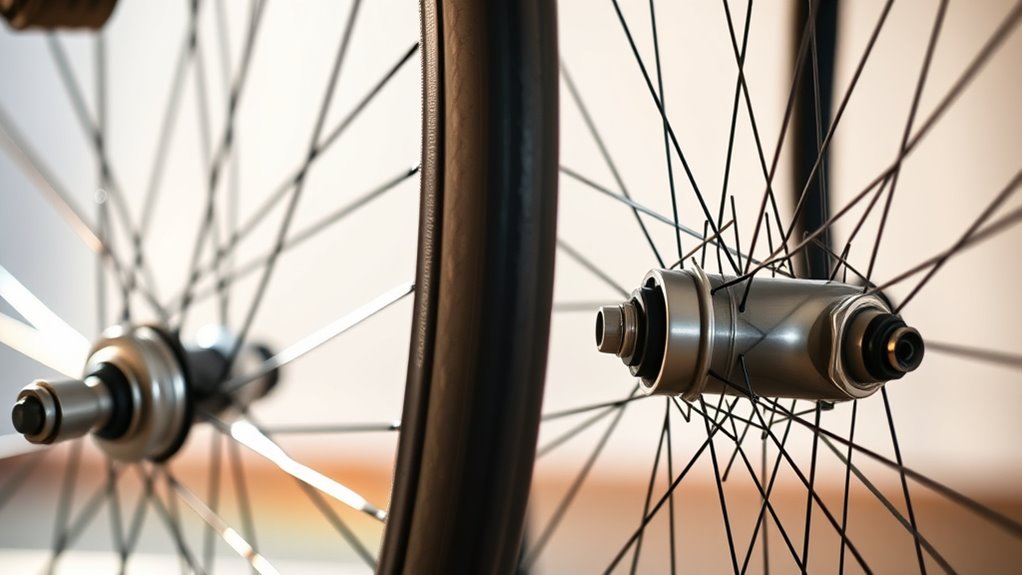
Both wheel-on and direct-drive trainers work by allowing you to ride indoors, but they achieve resistance through different mechanisms. Wheel-on trainers generate resistance by pressing a roller against your rear tire, creating friction as your wheel spins. This setup is quick and portable, but the contact can wear tires over time. In contrast, direct-drive trainers remove your rear wheel and mount your bike directly onto a fixed cassette, offering a more precise and maintenance-free resistance system through internal electromagnetic or hydraulic mechanisms. Compatibility is key for both types, as you need to ensure your bike’s axle and hub fit the trainer’s setup. While wheel-on trainers are easier to install, direct-drive models often provide a more stable and realistic ride experience due to their internal resistance mechanisms. Additionally, resistance control is often more accurate and consistent with direct-drive trainers, making them a popular choice for serious cyclists. Furthermore, the setup process for direct-drive trainers can be more involved but results in a smoother ride overall. For those seeking quiet operation, direct-drive trainers tend to produce less noise compared to wheel-on options, enhancing the indoor training experience. A hybrid approach can sometimes be used to combine portability with performance, depending on user needs. Incorporating advanced training features such as smart connectivity can further enhance your indoor cycling sessions.
Practicality and Convenience in Use
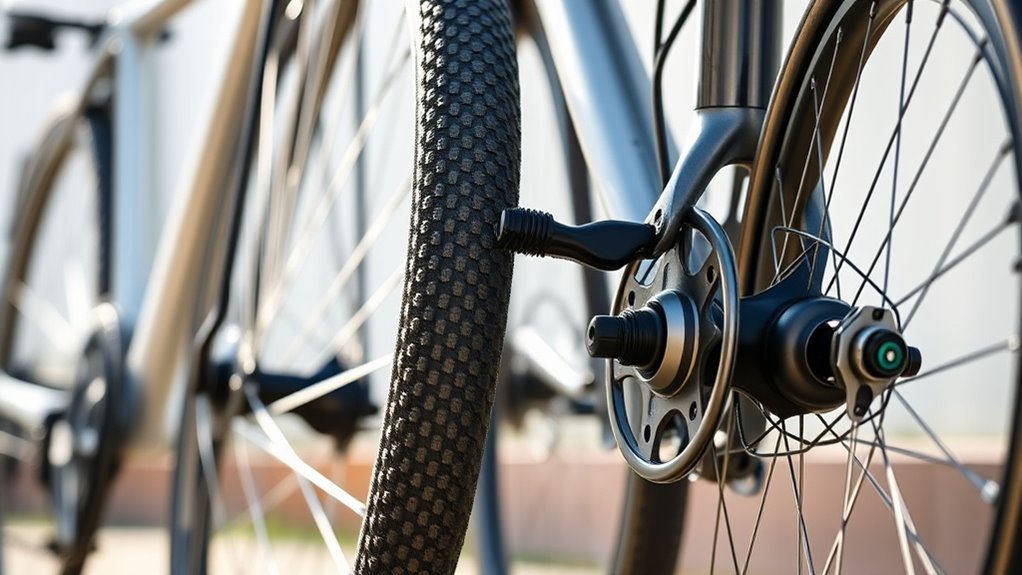
Wheel-on trainers are known for their quick and straightforward setup, making them a popular choice for warm-ups or casual rides. You simply attach your bike and adjust the rear wheel, which means less time spent on installation. Their portability is a major advantage—you can easily switch bikes without extra equipment, and moving them around is simple due to their lightweight design. This convenience makes wheel-on trainers ideal for quick sessions or those who value flexibility. In contrast, direct-drive trainers involve removing the rear wheel and installing the bike onto a cassette, which takes longer and is less portable. While more cumbersome to transport, direct-drive units offer a more stable ride. Overall, wheel-on trainers excel in practicality for everyday use and casual riders. Additionally, many users appreciate how wheel-on trainers facilitate easy adjustments during workouts, further enhancing their convenience. Moreover, the ability to quickly set up and pack away the trainer supports a dynamic training schedule, making wheel-on trainers a practical choice for busy cyclists. For some riders, the cost-effectiveness of wheel-on trainers also makes them an attractive option. Furthermore, advancements in design have improved their compatibility with various bike types, increasing their versatility.
Noise Levels and Maintenance Requirements
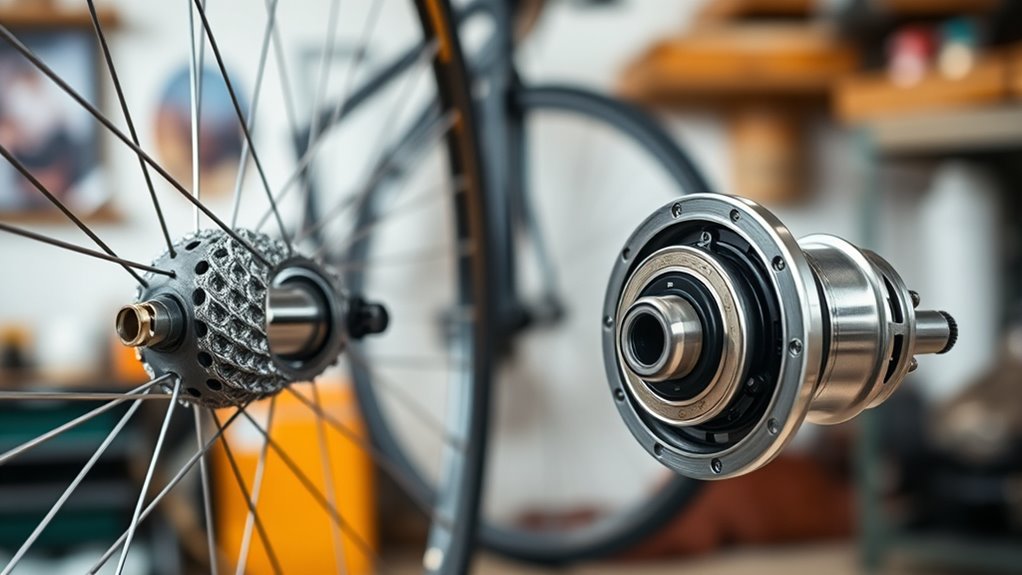
While wheel-on trainers are popular for their simplicity, they tend to be much noisier than direct-drive units because of tire contact and roller friction. This increased noise can disturb others in shared living spaces and makes them less ideal for noise-sensitive environments. Additionally, wheel-on trainers require regular maintenance, including tire pressure checks, tire replacements, and roller cleaning to maintain accuracy and performance. You’ll need to calibrate the trainer periodically to ensure consistent results. In contrast, direct-drive trainers operate with minimal noise—often comparable to a quiet refrigerator—since they eliminate tire contact. They demand less ongoing maintenance, mainly involving occasional belt and internal component checks, making them a more convenient, quieter choice over time. Moreover, direct-drive units often feature built-in cadence and power sensors, enhancing training data accuracy without additional equipment. Proper lubrication of internal parts can further extend the lifespan of a direct-drive trainer, reducing the need for repairs or replacements.
Data Accuracy and Power Measurement
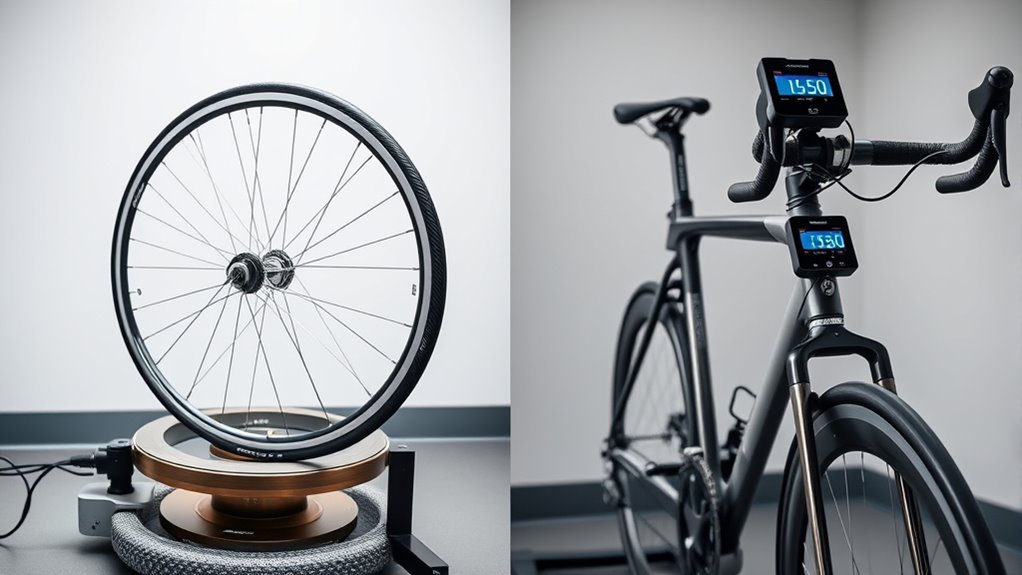
When it comes to data accuracy and power measurement, the type of trainer you choose can markedly impact your training results. Direct-drive trainers generally offer better accuracy, within +/- 2%, thanks to advanced internal sensors and a direct drivetrain connection. Wheel-on trainers, however, tend to have accuracy within +/- 3% to +/- 5%, relying on estimates based on roller speed and tire contact, which can lead to discrepancies during sprints or rapid accelerations. Calibration and firmware updates also influence data reliability across both types. For precise power measurement, especially during structured training, direct-drive trainers are preferred. Here’s a quick comparison:
| Feature | Wheel-On Trainer | Direct-Drive Trainer |
|---|---|---|
| Power measurement accuracy | +/- 3-5% | +/- 2% |
| Sensor type | Estimated via roller contact | Internal sensors |
| Calibration | Necessary | Critical |
| Data consistency | Less reliable | More reliable |
| Performance during sprints | Less precise | More precise |
Additionally, data accuracy can be affected by external factors such as tire pressure and contact quality, which are more controlled in direct-drive setups.
Price Range and Overall Affordability
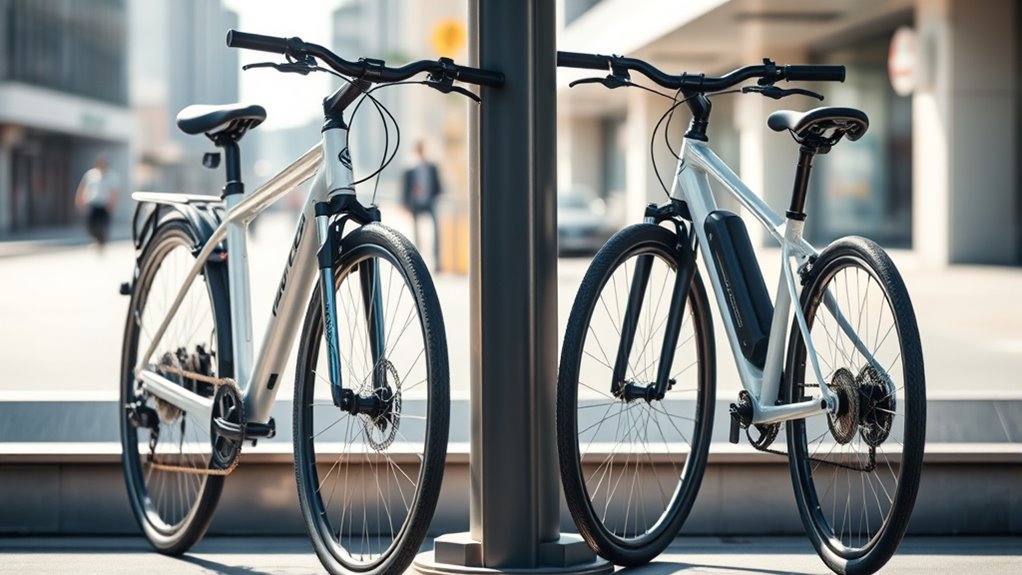
When choosing between wheel-on and direct-drive trainers, your budget plays a key role. Wheel-on models are more affordable upfront, but direct-drive options often offer better long-term value through durability and performance. Consider your training needs and how much you’re willing to invest for features that matter most to you. Additionally, cost considerations can help you make an informed decision aligned with your financial situation. Incorporating data-driven marketing strategies into your training routine can also enhance motivation and track your progress effectively. Moreover, understanding the trustworthiness of brands like Patchology can inform your overall purchasing confidence. Being aware of common tiny pitfalls in decision-making can help you avoid overspending or choosing subpar equipment.
Cost Differences and Value
Are you trying to decide between a wheel-on and a direct-drive trainer based on budget? The cost difference is significant: wheel-on trainers usually range from $200 to $600, while direct-drive models start at around $700 and can exceed $1,500. This initial investment impacts the overall value you get, especially if you’re a serious cyclist.
- Wheel-on trainers are more affordable upfront but may require extra spending on maintenance.
- Direct-drive trainers cost more initially but offer better durability and ride feel.
- Upgrading to a high-end direct-drive can be worthwhile for frequent trainers.
- Over time, the superior performance of direct-drive trainers often makes them a more cost-effective investment for dedicated use.
- Additionally, some Vetted – Deals Buy options include features that enhance the training experience and long-term value.
- Considering factors like longevity and maintenance costs and the training experience can help you make a more informed decision based on your training needs.
Understanding this difference helps you weigh the value of each option for your needs.
Budget-Friendly Options Available
If you’re looking for a budget-friendly indoor training option, wheel-on trainers offer an accessible entry point with prices typically ranging from $150 to $300. These budget trainers are ideal for casual riders or beginners seeking an affordable solution without sacrificing basic performance. Many entry-level models are simple to use and provide decent training quality, making them a practical choice for those on a tight budget. Additionally, some models include smart features that can enhance your training experience without significantly increasing the cost.
Long-Term Investment Benefits
Although direct-drive trainers often come with a higher initial price tag—typically around twice that of wheel-on models—they tend to be more cost-effective over the long run. Their durability, superior accuracy, and reduced maintenance needs make them a smart long-term investment. Spending more upfront on a quality direct-drive trainer can save you money on replacements and upgrades over five years, especially if you train frequently. Budget-friendly wheel-on trainers may have a lower initial cost but often require frequent calibration, tire replacements, and upgrades, increasing total ownership expenses. For dedicated indoor cyclists, investing in a mid- to high-end direct-drive trainer offers better value through enhanced performance, longevity, and lower ongoing maintenance costs.
- Increased durability reduces replacement needs
- Less frequent maintenance and calibration
- Higher accuracy improves training quality
- Greater long-term savings justify the initial investment
Compatibility With Apps and Virtual Riding Platforms
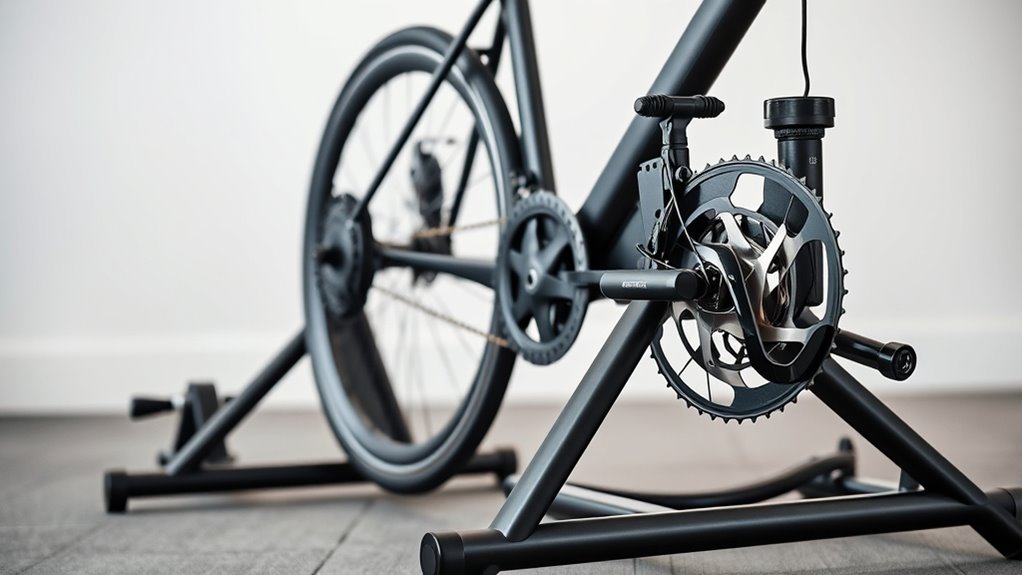
When it comes to virtual riding platforms, both wheel-on and direct-drive trainers support popular apps like Zwift, TrainerRoad, and Sufferfest through Bluetooth or ANT+ connections. Your choice depends on ensuring the trainer’s connectivity standards match your preferred virtual platforms. Most smart trainers include Bluetooth and ANT+ protocols, enabling seamless data transfer and resistance control. However, direct-drive trainers often provide more reliable and consistent connectivity because they have fewer hardware variables, like wheel slip or size discrepancies, that can interfere with signal stability. Some wheel-on trainers may require firmware updates for ideal app integration, especially for advanced features like ERG mode or gradient simulation. Always verify your trainer’s compatibility with your chosen virtual platform’s connectivity standards before making a purchase.
Ride Feel and Realism of the Cycling Experience

When it comes to ride feel and realism, direct-drive trainers often deliver a smoother, more authentic experience thanks to larger flywheels and precise resistance response. Wheel-on trainers can feel choppier and less natural due to smaller flywheels and tire contact issues, especially during quick efforts. Ultimately, the choice impacts how closely your indoor ride mimics outdoor cycling, especially during climbs and sprints.
Realism of Resistance Patterns
Direct-drive trainers generally deliver a more realistic ride feel because their larger flywheels and advanced resistance algorithms create smoother, more natural resistance patterns. This results in resistance that closely mimics outdoor gradients, especially during climbs and sprints, enhancing your training authenticity. They respond quickly to changes, maintaining accuracy during rapid efforts, unlike wheel-on trainers that can lag or feel less responsive. High-end models incorporate ERG mode and sophisticated firmware, providing consistent and precise resistance adjustments that mirror real riding conditions. The physical connection in direct-drive units allows for better resistance modulation and pedal feedback, making your indoor cycling experience feel more genuine.
- Resistance changes feel seamless and natural
- Accurate simulation of outdoor gradients
- Quick adaptation during sprints and climbs
- Consistent resistance in ERG mode
Ride Smoothness and Response
The ride feel and responsiveness of your trainer play a crucial role in simulating real cycling conditions. A direct drive trainer offers a superior ride feel thanks to its larger flywheel, which maintains momentum and provides a smoother, more natural ride. Its resistance response is immediate and accurate, closely mimicking real road sensations, especially during sprints and climbs. This results in better ride smoothness and stability, giving you more precise feedback during high-intensity efforts and terrain changes. In contrast, wheel-on trainers often have smaller flywheels and lighter resistance units, leading to a choppier ride feel. Wheel slippage and dead spots can also disrupt ride smoothness, making the experience less realistic. Overall, direct drive trainers deliver a more responsive and authentic cycling experience.
Natural Feel During Rides
Achieving a natural ride feel is essential for an immersive cycling experience, and the type of trainer you choose greatly influences that sensation. Direct-drive trainers tend to offer a more realistic feel because of larger flywheels and smoother resistance, closely mimicking outdoor cycling. They respond better to terrain changes like climbs or sprints, making your ride feel more authentic. Wheel-on trainers, on the other hand, often feel less natural, with lighter flywheels and tire contact points that can cause slippage and dead spots during intense efforts. The resistance algorithms and firmware updates in direct-drive models also enhance the overall feel, providing a more consistent and responsive ride. This results in a natural sensation, reducing artificial or bumpy feelings during high-intensity training.
Durability and Longevity of Each System

Because they have fewer moving parts and less friction, direct-drive trainers tend to last much longer than wheel-on models. They often feature robust construction and sealed mechanisms, enabling a lifespan of over 10 years with proper maintenance. Wheel-on trainers, on the other hand, typically require more frequent replacements of tires, rollers, or internal parts due to higher wear and tear. Lower-cost wheel-on options may degrade within 2-3 years, especially with frequent use or poor upkeep.
| Aspect | Direct-Drive Trainer | Wheel-On Trainer |
|---|---|---|
| Durability | Longer lifespan, over 10 years | Shorter lifespan, 2-3 years |
| Maintenance | Less frequent, sealed units | More frequent, wear-prone parts |
| Cost-Effectiveness | More cost-effective long-term | Less cost-effective upfront |
| Wear and Tear | Minimal | Higher due to tire and roller wear |
Suitability for Different Types of Riders

If you’re just starting out or casually riding, a wheel-on trainer offers quick setup and affordability, making it a practical choice. Serious cyclists and competitive riders usually prefer direct-drive trainers for their realistic feel and precise data. Consider your riding goals and bike type to find the system that best fits your needs.
Casual and Beginner Riders
For casual and beginner riders, wheel-on trainers are often the best choice due to their affordability and ease of use. You’ll find that setting up a wheel-on trainer is straightforward, requiring minimal technical knowledge. They’re compatible with most bikes without needing adapters, making the setup quick and hassle-free. These trainers are ideal if you train occasionally or want a simple way to get started with indoor cycling. Keep in mind, however, that they tend to be noisier and cause more drivetrain wear, but for casual riders, this isn’t a major concern. Overall, if you’re new to indoor cycling, a wheel-on trainer offers an accessible, cost-effective way to jump in without a steep learning curve. It’s a practical choice for those just starting out.
Serious and Competitive Cyclists
Serious and competitive cyclists often seek trainers that deliver accurate data and a realistic ride experience to optimize their training. Direct-drive trainers excel in precision, offering accuracy within +/- 2%, which is essential for tracking performance and making informed training decisions. They also provide superior resistance response and smoother gradients, allowing you to simulate outdoor terrain and perform structured workouts effectively. While wheel-on trainers are more affordable, their lower data accuracy (+/- 3-5%) and noisier operation make them less ideal for high-level training. High-end direct-drive units feature larger flywheels and advanced resistance algorithms, creating a road-like feel that enhances your performance. For competitive cyclists, investing in a direct-drive trainer is justified by its durability, reliability, and ability to elevate training quality.
Market Trends and Future Developments
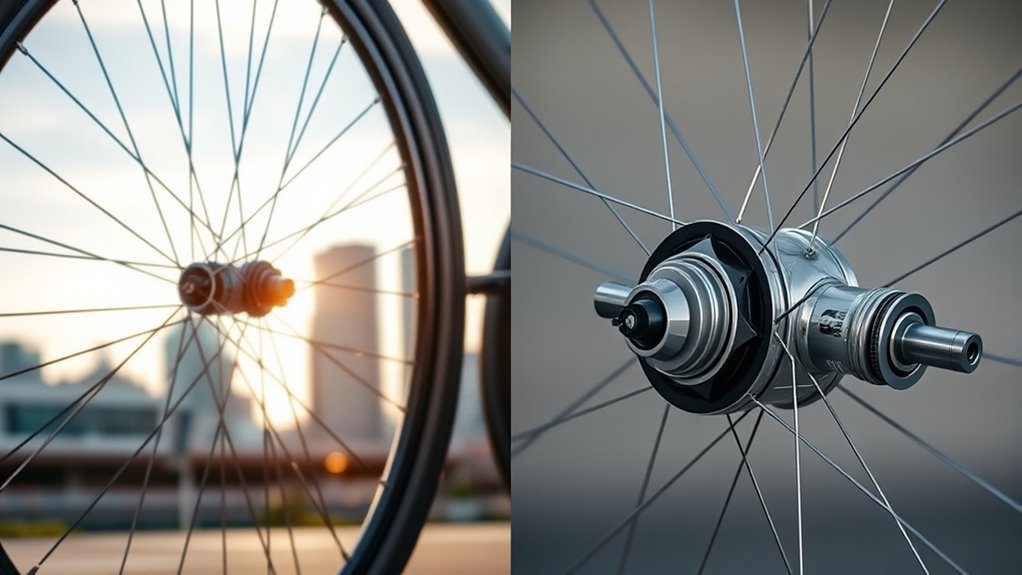
Market trends show a clear shift toward direct-drive trainers, driven by their superior realism, quieter operation, and more accurate data. As industry forecasts predict, smart trainers will increasingly feature automatic calibration, multi-bike compatibility, and seamless virtual riding integration. You can expect future developments to focus on quieter, more durable models that suit urban and shared living spaces. Manufacturers are investing in hybrid models and integrated smart trainer bikes to combine wheel-on simplicity with direct-drive realism. These innovations aim to address evolving consumer demands and elevate indoor cycling experiences. As the industry moves forward, advancements in firmware and resistance algorithms will continue to enhance terrain simulation and responsiveness, shaping the future of indoor training. Staying aware of these trends helps you choose the most innovative and future-proof equipment.
Frequently Asked Questions
What Is the Difference Between Wheel on and Direct Drive?
You want to know the difference between wheel-on and direct-drive trainers. Wheel-on trainers attach to your bike’s rear wheel, making them easy to set up and portable, but they can cause tire wear and noise. Direct-drive trainers remove the wheel and offer a more stable, accurate ride with smoother resistance, reducing maintenance. They’re generally better for serious training, while wheel-on units suit casual or portable use.
Is Direct Drive More Realistic?
Imagine you’re training for a mountain climb; a direct-drive trainer offers a more realistic experience. It mimics road feel more accurately with larger flywheels and responsive resistance, making climbs and sprints feel genuine. You’ll notice smoother resistance changes and terrain variations that closely match outdoor gradients. Without slipping or drivetrain issues, your pedaling feels natural and consistent, giving you a more immersive, realistic ride compared to wheel-on trainers.
Which Indoor Trainer Is Best?
When choosing the best indoor trainer, consider your goals and budget. If you want precision and durability for serious training, a direct-drive trainer is your best option because it offers more accurate power measurement, quieter operation, and less maintenance. However, if you’re a casual rider seeking affordability and portability, a wheel-on trainer works well. Think about your space, riding frequency, and how much you’re willing to invest to find the perfect fit.
Is a Direct Drive Trainer Worth It?
You might wonder if a direct drive trainer is worth it. Imagine riding with a power measurement accuracy within just 2%—that’s incredibly precise. If you’re serious about improving, the quieter operation, realistic feel, and durability make it a smart investment, especially for regular training. While it costs more upfront, the reduced maintenance and better performance can save you time and money in the long run.
Conclusion
Choosing between wheel-on and direct-drive trainers is like picking the right gear for your ride—each offers a different feel and purpose. Wheel-on trainers are your trusty, portable companions for quick setups, while direct-drive systems are the solid, dependable engine for serious training. Consider your goals, space, and budget. Whichever you choose, remember it’s about keeping your cycling journey smooth and steady—like steering through open roads toward your next achievement.









